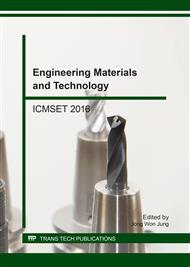[1]
Y. M. Wang, S. W. Liu, M. K. Lu, S. F. Wang, F. Gu, X. Z. Gai, X. P. Cui, J. Pan, Preparation and photocatalytic properties of Zr4+-doped TiO2 nanocrystals, J. Molecul. Catal. A: Chem. 215(1-2) (2004) 137-142.
DOI: 10.1016/j.molcata.2004.01.007
Google Scholar
[2]
G. K. Kiema, M. J. Colgan, M. J. Brett, Dye Sensitized solar cells incorporating obliquely deposited titanium oxide layers, Sol. Energy Mater. Sol. cell, 85(3) (2005) 321-331.
DOI: 10.1016/j.solmat.2004.05.001
Google Scholar
[3]
K. S. Raji, T. Gandhi, M. Misra, Effect of water content of ethylene glycol as electrolyte for synthesis of ordered titania nanotube, Electrochem. Commun. 9(5) (2007) 1069-1076.
DOI: 10.1016/j.elecom.2006.12.024
Google Scholar
[4]
C. Wilaiwan, W. Apichon, C. R. Chenthamarakshan, K. Puangrat, N. R. de Tacconi, K. Rajeshwar, Titania nanotubes from pulse anodization of titanium foils, Electrochem. Commun. 9(8) (2007) 2145-2149.
DOI: 10.1016/j.elecom.2007.06.006
Google Scholar
[5]
O. Carp, C. L. Huisman, A. Reller, Photoinduced reactivity of titanium dioxide, Prog. Solid State Chem. 32 (2004) 33-177.
Google Scholar
[6]
A. Fujishima, T. N. Rao, D. A. Tryk, Titanium dioxide photocatalysis, J. Photochem. Photobiol. C: Photochem. Rev. 1(1) (2000) 1-21.
Google Scholar
[7]
E. Ritter, Dielectric film materials for optical applications, Phys. thin film 8 (1975) 1-49.
Google Scholar
[8]
H. K. Pulker, Coatings on Glass Substrates, Thin Solid Film 77 (1981) 203-212.
DOI: 10.1016/0040-6090(81)90376-x
Google Scholar
[9]
L. E. Fraga, M. A. Anderson, M. L. P. M. A. Beatriz, F. M. M. Paschoal, L. P. Romão, M. V. B. Zanoni, Evaluation of the photoelectrocatalytic method for oxidizing chloride and simultaneous removal of microcystin toxins in surface water, Electrochim. Acta 54(7) (2009).
DOI: 10.1016/j.electacta.2008.08.060
Google Scholar
[10]
P. Y. Simons, F. Dachille, The structure of TiO2II, a high-pressure phase of TiO2, Acta Crystallor 23 (1967) 334-336.
Google Scholar
[11]
Y. Takahasi, N. Kijima, J. Akimoto, Synthesis, Structural Change upon Heating, and Electronic Structure of Ramsdellite-Type TiO2., Chem. Mater. 18(3) (2006) 748-752.
DOI: 10.1021/cm0521370
Google Scholar
[12]
Y. Ao, Y. Gao, P. Wang, C. Wang, J. Hou, J. Quan, Solvent-controlled preparation and photocatalytic properties of nanostructured TiO2 thin films with different morphologies, Mater. Res. Bull. 49 (2014) 223-228.
DOI: 10.1016/j.materresbull.2013.09.002
Google Scholar
[13]
N. l. Ermokhina, V. A. Nevinskiy, P. A. Manorik, V. G. llyin, N. N. Shcherbatyuk, D. O. Klymchyuk, A. M. Puziy, Synthesis of large-pore mesoporous nanocrystallin TiO2 microspheres, Mater. Lett. 75 (2012) 68-70.
DOI: 10.1016/j.matlet.2012.01.133
Google Scholar
[14]
M. Kitano, K. Funatsu, M. Matsuoka, M. Ueshima, M. Anpo, Preparation of nitrogen-substituted TiO2 thin film photocatalysts by the radio frequency magnetron sputtering deposition method and their photocatalytic reactivity under visible light irradiation, J. Phys. Chem. B 110(50) (2006).
DOI: 10.1021/jp064893e
Google Scholar
[15]
T. Oishi, T. Matsubara, A. Katagiri, Formation of porous TiO2 by anodic oxidation and chemical etching of titanium, Electrochem. 68 (2000) 106-111.
DOI: 10.5796/electrochemistry.68.106
Google Scholar
[16]
P. Roy, S. Berger, P. Schmuki, TiO2 Nanotube: Synthesis and Application, Anewandte Chemie 50(13) (2011) 2904-2939.
DOI: 10.1002/anie.201001374
Google Scholar
[17]
S. H. Wang, X. W. Zhou, X. R. Xiao, Y. Y. Fang, Y. Lin, An Increase in conversion efficiency of Dry-Sensitized solar cells using bamboo-type TiO2 Nanotube Arrays, Electrochimica Acta, 116 (2014) 26-30.
DOI: 10.1016/j.electacta.2013.11.011
Google Scholar
[18]
D. Kim, A. Ghicov, S. P. Albu, P. Schmuki, Bamboo-Type TiO2 Nanotubes: Improved Conversion Efficiency in Dye-Sensitized Solar Cell, Dpt. Mater. Sci. 130(49) (2008) 16454-16455.
DOI: 10.1021/ja805201v
Google Scholar
[19]
Y. L. Xie, Z. X. Li, H. Xu, K. F. Xie, Z. G. Xu, H. L. Zhang, Fabrication of TiO2 nanotube with extended periodical morphology by alternating-current anodization, Electrochem. Commun. 17 (2012) 34-37.
DOI: 10.1016/j.elecom.2012.01.021
Google Scholar
[20]
Y. Sun, G. Wang, K. Yan, TiO2 nanotubes for hydrogen generation by photocatalytic water splitting in a two-compartment photoelectrochemical cell. Int. J. Hydr. Energ. 36 (2011) 15502-15508.
DOI: 10.1016/j.ijhydene.2011.08.112
Google Scholar
[21]
A. G. Kontos, A. Katsanaki, V. Likodimos, T. Maggos, D. Kim, C. Vasilakos, D. D. Dionysiou, P. Sckmuki, P. Falaras, Continuous flow photocatalytic oxidation of nitrogen oxides over anodized nanotubular titania film. Chem. Eng. J. 179 (2012).
DOI: 10.1016/j.cej.2011.10.072
Google Scholar
[22]
Z. Y. Liu, X. T. Zhang, S. Nishimoto, M. Jin, D. A. Tryk, T. Murakami, Highly ordered TiO2 nanotube arrays with controllable length for photoelectrocatalytic degradation of phenol, Phys. Chem. C 112(1) (2008) 253-259.
DOI: 10.1021/jp0772732
Google Scholar
[23]
Y. B. Xie, L. M. Zhou, J. Lu, Photoelectrochemical behavior of titania nanotube array grown on nanocrystallin titanium, Mater. Sci. 44(11) (2009) 2907-2915.
DOI: 10.1007/s10853-009-3384-0
Google Scholar
[24]
L. Li, Z. Zhou, J. Lei, J. He, S. Wu, F. Pan, Facile fabrication of a dual hierarchical TiO2 nanostructure, Master. Lett. 68 (2012) 290-292.
DOI: 10.1016/j.matlet.2011.10.104
Google Scholar
[25]
Y. Zhang, D. J. Wang, S. Pang, Y. H. Lin, T. F. Jiang, T. F. Xie, A study on photogenerated charges property in highly ordered TiO2 nanotube array, Appl. Surf. Sci. 256(23) (2010) 7217-7221.
DOI: 10.1016/j.apsusc.2010.05.054
Google Scholar
[26]
H. P. Klun, L. E. Alexander, X-Ray Diffraction Procedures for Polycrystalline and Amorphous Material, John Wiley & Sons Incorporated, New York (1974) 791-859.
Google Scholar


